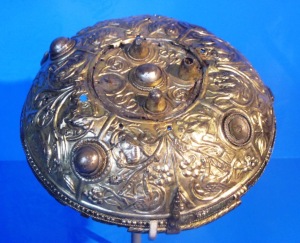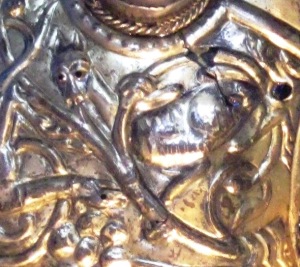Whilst on my travels in York recently (I do leave Cumbria occasionally) I came across this in the Yorkshire Museum.
The Ormside Bowl was found near St James’ Church in the village of Great Ormside in the Eden Valley in the early 1800s. The circumstances of its discovery aren’t clear; it was long assumed it was found buried, but at least one archaeologist1 has suggested that the condition is too good for that to be the case.
It’s really two bowls fastened together. The outside, the oldest part, is made of silver-gilt and dates to the mid 8th century. The inner part was made about a hundred years later from cheaper gilt-bronze and decorated with blue glass studs. The two parts were fastened together with silver clips in the shape of animal heads.
The older part of the bowl is decorated in a style known as repoussée (the metal is pushed through from the back to create a ‘raised’ pattern) with scrolling vines and sixteen creatures. Some are birds, and some are mysterious four-legged animals that never roamed this earth (as far as I know!). The style is distinctive and typical of work created for anglian monasteries in Northumbria in the mid 750s.
The period immediately after the manufacture of the Ormside Bowl was a significant one in the history of those northeastern monasteries. As is reported in the Anglo-Saxon Chronicle in 793CE, ‘in this year fierce, foreboding omens came over the land of the Northumbrians, and the wretched people shook; there were excessive whirlwinds, lightning, and fiery dragons were seen flying in the sky. These signs were followed by great famine, and a little after those, that same year on 6th ides of January, the ravaging of wretched heathen people destroyed God’s church at Lindisfarne’. Those ‘wretched heathen people’ were, of course, the vikings. It was no mere smash-and-grab, either, as Alcuin reported: ‘Never before has such terror appeared in Britain as we have now suffered from a pagan race… the heathens poured out the blood of saints around the altar, and trampled on the bodies of saints in the temple of God, like dung in the streets’.
The reason historians believe2 the Ormside Bowl may have been one of the items stolen in those ‘heathen’ raids is that the later addition – the inner part – was made in a style used by viking settlers in the following century. The blue glass studs have even been tentatively matched to glass manufacture at Coppergate in York, where extensive remains of a viking settlement now underlie the famous Jorvik Museum.
So, how did the Ormside Bowl, made in Northumbria, and pimped up in York, end up in Cumbria? In 1893, a viking burial3 was found outside the church in Great Ormside that is associated with the Ormside Bowl. Dated to the 9th century – the same as the inner bit of the bowl – the skeleton was found with a sword, knife, a shield boss and an iron rod. Was the Ormside Bowl originally in the burial, too? Or perhaps it belonged to him, but somehow ended up back in the church’s ‘treasure’ in this small village? Or was it owned by a family descended from those early Norse invaders, now settled in Cumbria? And if it wasn’t buried, how do you lose such a costly thing?
The Ormside Bowl is particularly special because there is surprisingly little archaeological evidence of the vikings in Cumbria, despite the fact that we trip over viking place-names (all those -thwaites and becks) and viking surnames (-thwaites, -becks and Birketts) every day of our lives. We have a couple of gorgeous pins from the Penrith area, and we are still waiting for the conservation to finish on the finds from the viking burials found at Cumwhitton nearly a decade ago.
And we have to go to York to see this piece of viking Cumbria. Boo. 4
- David Wilson, (2003). Ormside Bowl in Reallexikon der Germanischen Altertumskunde. pp. 218–220.
- See the Yorkshire Museum.
- Now in Tullie House Museum, Carlisle – except the knife, which has gone missing. This is the Pastscape archaeological record.
- Mind, I do like York.



Boo, but really interesting. What do they think that such a highly engraved bowl/s would be used for? Did the latter bowl sit inside the earlier or did it form a sort of lid?
Hi Carol! The inner bit of the bowl – which I couldn’t photograph because of the way it’s displayed – is mostly plain, with a bit of silver filigree scrollwork and those blue glass studs. The inner and outer bowls were ‘clipped’ together with four silver animal head fastenings (of which two remain), one inside the other. The theory is that in its Viking days, it was a rather posh drinking cup, but who knows why it needed its liner. Perhaps the outer bit had holes in even then.
Given that only one of the blue glass studs remains in situ, with several empty fittings, I wonder if they checked the Viking skeleton’s innards for blue glass… 😉
I like that idea! Oops I think I just swallowed a bit of glass!
At least it’s not London…
Incidentally, Bede, deceased 735, is not the source of the report on the attack on Lindisfarne. That’s from the root text of the Anglo-saxon Chronicle.
How big is the bowl, as my impression is that it looks wrong for drinking from, and more like a display piece. Maybe a fruit bowl…
I’m never convinced this sort of thing was for drinking (sure, Vikings drunk, but would they really have been effective if they were permanently drunk or hungover), so unless someone chemically finds wine patina or the like (unlikely as this has been cleaned), I would prefer to suggest this was a high-status fruit bowl…
Incidentally, Bede died in 734; your quote on the attack on Lindisfarne is from memory from the root stock of the Anglo-Saxon Chronicle.
Hi Allan – sorry your reply didn’t appear; I’ve opened up this morning to a major spam-bombing that seems to have resulted in Akismet chucking everything in the bin!
Thanks for the correction on Bede/ A-S Chronicle. That’ll teach me to quote things from memory. I’ve adjusted accordingly.
I actually took a photo of the caption at the Yorkshire Museum, and yes, it really does say it’s a drinking bowl. It doesn’t look very cup-ish to me, either. It’s about the size of a soup bowl; maybe a tad bigger. Not really big enough for fruit… 😉
A few of the captions at the Yorkshire Museum looked slightly off, like the rush to claim it for York because of the possibility the blue glass nodules on the inside could have been made in Coppergate. That may well be the case but the rest of the story surely allies it at least equally with Northumbria and Cumbria. They seem to take the opposite strategy to Tullie House in Carlisle; Tullie seems to bend over backwards to *not* claim its own (the Embleton Sword remains unlabelled, grumble grumble) whereas York snatches stuff out of its neighbours’ grasp. Perhaps they are precisely as Viking as they think they are… 😉 😀
It’s beautiful! And you have to love an historical object with a mystery behind it.
It is a good one, isn’t it? Mind, these whopping great brooches are rather more spectacular – and enormous.
Thanks for coming over!